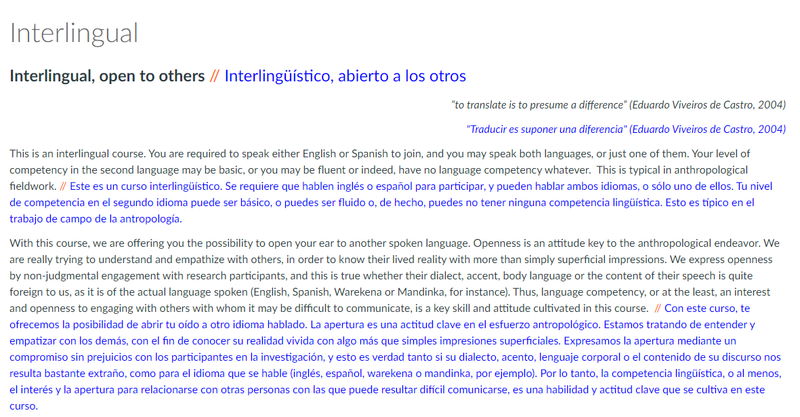- Group size: Maximum 33 students
- Teaching type: Field school
- Division: Social Sciences (Global Campus Social Enterprise, spin-out of the School of Anthropology and Museum Ethnography)
- Subject: Qualitative Research Methods
- Tools: Canvas, Panopto, Microsoft Teams
Broadly speaking, this course fits into the FIT pathway: Small group - option 2, but without in-person meetings due to the international target group.
Delivery
This immersive interlingual (English–Spanish) and intercultural introduction to methods in anthropology, equips students with all the skills they need to undertake fieldwork in innovative and ethical collaboration with research participants. The course is offered worldwide. It was designed and is tutored by three anthropologists with methods expertise, Elizabeth Rahman and Alejandro Reig at the University of Oxford, and Nicolas Naranjo at the University of La Laguna. The course is organised around three core modules with content being a combination of English and Spanish language resources hosted in Canvas. Students are encouraged to collaborate to access areas outside of their linguistic competency. The format includes written content, practical activities and their reporting – using primarily asynchronous discussions. We have four real-time MS Teams meetings per semester.
Content types include:
-
Text on screen
-
Pre-recorded “anthropological dialogues” between course facilitators
-
Pre-recorded PowerPoint presentations
-
Articles and book chapters
-
Core texts, monographs and edited volumes
-
Audio-visual and transmedia productions: ethnographic film and video, fiction and non-fiction reportage, “hybrid” transdisciplinary narrations and media across different technical formats
-
TED and YouTube videos
-
Podcasts
-
Range of digital technologies (eg mentimeter)
-
Quizzes
-
Photos, images and other graphic resources
-
Online blogs, websites and other internet resources.
Students are tasked with:
-
summarising articles about methodology
-
conducting individual fieldwork activities, including keeping field notes for the duration of the course
-
answering reflective questions in a group
-
completing quizzes
-
participating in online graded discussions, including posting completed tasks (eg extracts from fieldnotes, or maps made)
-
submitting formative assessed essays.
Strengths
-
Blended learning: While we aim to move forward as a cohort, the pre-recorded materials and asynchronous fora mean that students can access resources at any time. Real-time meetings clarify and wrap up topics and themes.
-
Collaboration: Facilitators model collaboration in the course design and content and students follow suit in their tasks, which they can also tailor to their interests. Students collaborate in order to a) understand interlingual content; 2) undertake the tasks that actively practice the research methods themselves, eg practice object elicitation techniques as part of an interview with a peer or engage in a focus group.
-
Formative learning: While students are engaged in continuous assessment for the duration of course they also undertake a formative task, where they receive tutor feedback and then re-post their assignments for peer-to-peer feedback in the discussions area.
-
Design and tutoring: Tutors must work collaboratively and nurture their relationships to ensure effective delivery. This presents a great opportunity to share professional knowledge and experience for the benefit of students.
-
Peer-to-peer learning: As an inter-university course – with a mix of undergraduates, graduates (including from other disciplines), activists and professionals looking to use qualitative methods – students have an exceptional opportunity to learn from the projects and experience of others.
Limitations
-
Collaborative design: Although extremely gratifying, this was time-consuming, involving much dialogue (akin to anthropological work itself). It is hard to feel properly compensated for the amount of time and commitment devoted to the course.
-
Tutoring: Having three active tutors involves a careful division of labour and they need to weigh the extent of their interactions and avoid the temptation to “over teach”.
-
Discussions: These have the potential to become “chat” spaces, with some students posting unsubstantial posts. Careful guidance and monitoring of discussion threads are needed due to the extent of opportunities to diverge from the discussion at hand. Going back and forth between discussions as students complete activities at different times can prove tiresome for tutors.
-
International audience: Real-time meetings need to consider differences in time zones.

Figure 1. Collaborative methods teaching in practice, Nicolas Naranjo (University of Laguna), Elizabeth Rahman and Alejandro Reig (University of Oxford)

Figure 2. Visual aids hosted in Canvas

Figure 3. Text on Canvas screen showing interlingual collaboration in the course, which is expected of students